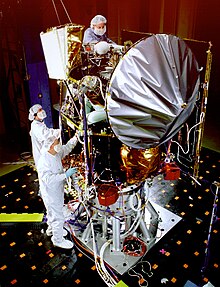Mars Climate Orbiter
Mars Climate Orbiter (MCO) was a NASA probe to Mars as part of the Discovery program . It was lost in 1999 due to a unit error in the navigation system.
Instruments
Mars Climate Orbiter was built together with Mars Global Surveyor so that the instruments of the lost Mars Observer could still be used. While four Mars Observer experiments flew on Mars Global Surveyor, Mars Climate Orbiter was equipped with only one: the PMIRR (Pressure Modulated Infrared Radiometer), which was supposed to examine the Martian climate by analyzing the radiation reflected from Mars . In addition, a camera, the Mars Color Imager (MARCI) was integrated. In addition to the climate study, the MCO's task was to act as a relay for the also failed Mars Polar Lander .
mission
MCO launched on December 11, 1998 aboard a Delta II 7425 from the Cape Canaveral spaceport . On September 23, 1999, the probe reached Mars and started its engine to be captured by Mars gravity . Initially an elliptical orbit of 150 km × 21,000 km was planned, by braking by means of aerobraking , the MCO should reach the final, almost circular orbit at an altitude of 421 km within 44 days . But when the probe emerged from the radio shadow of Mars again after the braking maneuver , contact could no longer be established.
loss
The investigation committee quickly found the reason for the loss of the probe. The telemetry data showed that she had approached Mars not within 150 km, but only 57 km. At this altitude, the Martian atmosphere is so dense that the probe had to be destroyed by the frictional heat. The cause of this navigation error was also soon determined: While NASA had calculated the momentum p in the International System of Units (SI) with the metric unit N s , the navigation software of the MCO from the manufacturer Lockheed Martin was designed in the imperial system with the momentum unit lb f s , which delivers values that are 1 / 4.45 lower. A by the solar pressure to compensate for forces acting on the asymmetrical mounted solar panel swirl, several course corrections needed to be made. Due to the different units, however, the course was overcorrected and the probe was brought far too close to Mars.
A lack of experience, overload and poor cooperation between the ground crews were cited as further causes of the loss. Well-rehearsed teams could have discovered the unit error during the flight and thus prevented the total loss.
See also
Web links
- The Mars Climate Orbiter
- Mars Climate Orbiter in the NSSDCA Master Catalog (English)
Individual evidence
- ↑ Mars Climate Orbiter Mishap Investigation Board: Mars Climate Orbiter Mishap Investigation Board Phase I Report. November 10, 1999, accessed March 15, 2019 .



